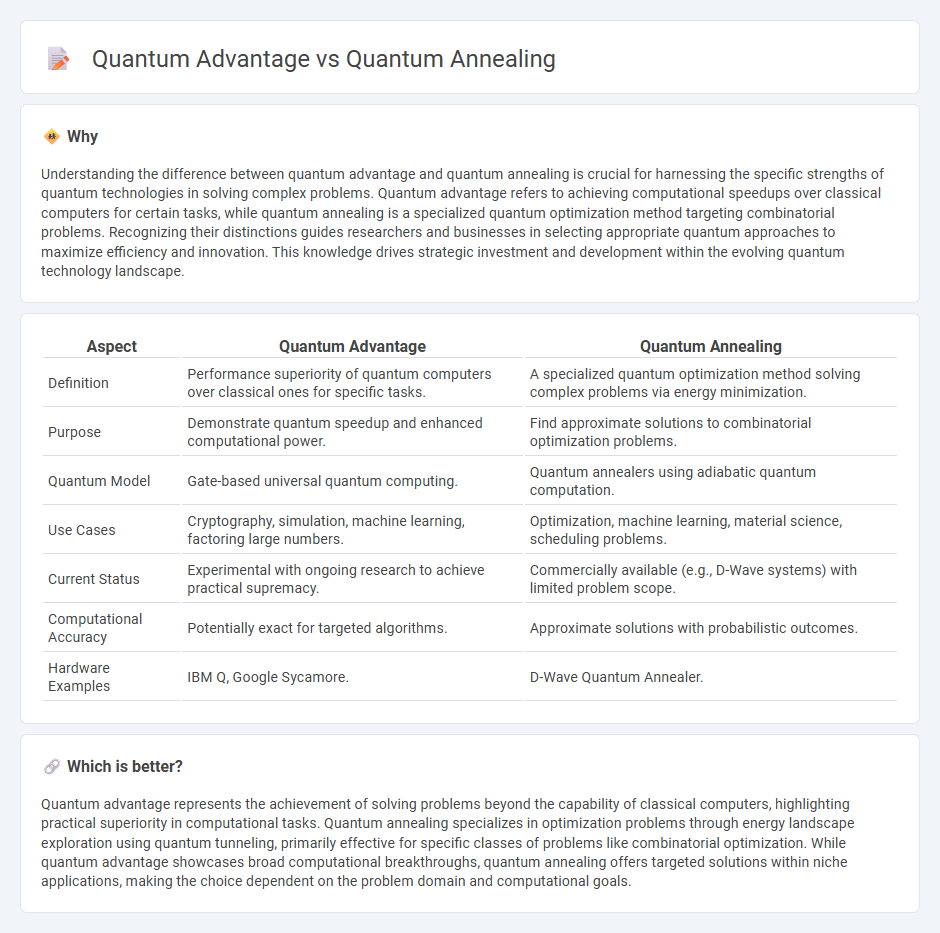
Quantum advantage represents the point where quantum computers outperform classical counterparts in solving specific problems, highlighting breakthroughs in computational speed and efficiency. Quantum annealing is a specialized quantum optimization technique that uses quantum fluctuations to find minimum energy states, primarily applied in solving complex optimization problems. Explore the distinctions between quantum advantage and quantum annealing to understand their impact on the future of computing.
Why it is important
Understanding the difference between quantum advantage and quantum annealing is crucial for harnessing the specific strengths of quantum technologies in solving complex problems. Quantum advantage refers to achieving computational speedups over classical computers for certain tasks, while quantum annealing is a specialized quantum optimization method targeting combinatorial problems. Recognizing their distinctions guides researchers and businesses in selecting appropriate quantum approaches to maximize efficiency and innovation. This knowledge drives strategic investment and development within the evolving quantum technology landscape.
Comparison Table
| Aspect | Quantum Advantage | Quantum Annealing |
|---|---|---|
| Definition | Performance superiority of quantum computers over classical ones for specific tasks. | A specialized quantum optimization method solving complex problems via energy minimization. |
| Purpose | Demonstrate quantum speedup and enhanced computational power. | Find approximate solutions to combinatorial optimization problems. |
| Quantum Model | Gate-based universal quantum computing. | Quantum annealers using adiabatic quantum computation. |
| Use Cases | Cryptography, simulation, machine learning, factoring large numbers. | Optimization, machine learning, material science, scheduling problems. |
| Current Status | Experimental with ongoing research to achieve practical supremacy. | Commercially available (e.g., D-Wave systems) with limited problem scope. |
| Computational Accuracy | Potentially exact for targeted algorithms. | Approximate solutions with probabilistic outcomes. |
| Hardware Examples | IBM Q, Google Sycamore. | D-Wave Quantum Annealer. |
Which is better?
Quantum advantage represents the achievement of solving problems beyond the capability of classical computers, highlighting practical superiority in computational tasks. Quantum annealing specializes in optimization problems through energy landscape exploration using quantum tunneling, primarily effective for specific classes of problems like combinatorial optimization. While quantum advantage showcases broad computational breakthroughs, quantum annealing offers targeted solutions within niche applications, making the choice dependent on the problem domain and computational goals.
Connection
Quantum advantage leverages quantum annealing to solve optimization problems more efficiently than classical algorithms by exploiting quantum tunneling and superposition. Quantum annealing techniques enable the exploration of complex energy landscapes, finding global minima faster and thus demonstrating practical quantum advantage in specific computational tasks. This connection is critical for advancing quantum computing applications in fields like material science, cryptography, and machine learning.
Key Terms
Optimization
Quantum annealing leverages quantum fluctuations to find global minima in complex optimization problems, efficiently solving combinatorial tasks like scheduling and material design. Quantum advantage refers to surpassing classical algorithms' performance, with quantum annealing demonstrating potential speedups in specific optimization cases. Explore how quantum annealing achieves optimization breakthroughs and its role in realizing quantum advantage.
Quantum Supremacy
Quantum annealing, designed for solving optimization problems via energy minimization, contrasts with quantum advantage, which signifies a quantum device outperforming classical counterparts in specific tasks. Quantum supremacy, a subset of quantum advantage, specifically highlights quantum computers completing problems infeasible for classical supercomputers. Explore the nuances of how quantum supremacy benchmarks quantum growth and its implications for computing advancements.
Qubit
Quantum annealing utilizes qubits to solve optimization problems by exploiting quantum tunneling, allowing the system to find lower energy states faster than classical methods. Quantum advantage refers to achieving computational tasks significantly faster or more efficiently than classical computers using qubits in different quantum algorithms. Explore how qubit properties impact these quantum technologies and their potential applications.
Source and External Links
What is Quantum Annealing? - D-Wave Documentation - Quantum annealing leverages quantum mechanics to find low-energy (optimal) solutions by evolving entangled quantum bits from superposition states into classical answers that minimize a defined energy landscape.
Quantum Annealing - Quantum annealing is an optimization process that exploits quantum tunneling to find global minima, theoretically outperforming classical thermal annealing especially in problems with narrow but high barriers between local minima.
Quantum Annealing: An Overview - Recent research reviews highlight quantum annealing as a potentially powerful approach for optimization, discussing both its theoretical foundations, practical challenges, and ongoing debates about its quantum speedup relative to classical methods.
 dowidth.com
dowidth.com